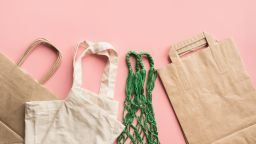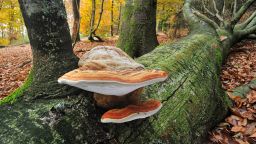Sign up for CNN’s Life, But Greener newsletter. Our limited newsletter series guides you on how to minimize your personal role in the climate crisis — and reduce your eco-anxiety.
Come spring, avid gardeners dig into the new growing season ready with careful cultivation plans they dreamed up over long winters. But even city-dwelling non-planners can benefit from year-round botanical bounty. They just need to learn what, where and how to harvest the wild foods growing in lawns, parks and scrubby backlots.
Chickweed, dandelion and dock provide delicious, nutrient-rich greens, while daylilies, lilacs, honeysuckle and roses can add floral overtones to syrups, jellies and baked goods. Protein-packed wild plants and plant parts include purslane, acorns and brown dock seeds. Teas and tinctures made from ground ivy, gingko and golden rod, along with many other “weeds” and invasive species, can serve various medicinal purposes, once properly prepared.
In her book “Urban Foraging: Find, Gather, and Cook 50 Wild Plants,” herbalist and expert forager Lisa M. Rose offers guidance on safely identifying, gathering and preparing edible flora that grow wild in most major US cities.
“Gathering your own food to make dinner can help instill a sense of place,” she said. She maintains that highlighting the role of wild plants in our food system can teach us to heal our soil, our waterways and our own public health. In this way, urban foraging creates new potential for greener, healthier and more sustainable ecosystems.
This conversation has been edited and condensed for clarity.
CNN: What makes you so passionate about urban foraging?
Lisa M. Rose: “Oh my gosh, you can EAT those?” pretty much sums up the thrill of urban foraging. Showing people all the edible plants that grow in cities helps connect them with the natural world.
It’s revolutionary to think differently of the unloved weeds and see opportunity in the neglected spaces that people pass by. The most fun, engaging thing is to get back outside and reconnect with the happiness that a dandelion flower can bring. Reinhabiting our 8-year-old, judgment-free selves allows us to recognize an elemental, earthly kind of beauty without the preconceived notions.
Plus, wild plants have a unique function in the ecosystem. Even so-called invasive species can remediate the soil and water. They help to repair areas that have been leveled and left open to erosion by creating a structure that keeps the soil from blowing away. Soil is the building block of human health, and it needs a rich, diverse base of organic material to be able to give us nutritious food.
CNN: What safety precautions do you recommend for people foraging in cities?
Rose: My family is from Flint, Michigan. I take soil and water contamination issues very seriously. The first steps to safe urban foraging are knowing where to harvest — including researching the history of the land, if possible — and learning which plants and plant parts may be more likely to contain contaminants like heavy metals or pollutants.

Nettles, for example, are apt to take up heavy metals like lead. So, I recommend harvesting these only from places free of soil contamination. The key is to take caution and be judicious. But remember, given the realities of our industrialized food system, the plants available at a commercial supermarket often have layers of pesticides. We don’t live in a perfect world.
Also, it sounds silly, but when it comes to plants or mushrooms, if you don’t know what it is, don’t pick it, and definitely don’t put it in your mouth!
CNN: What does it mean to forage responsibly? How can we take from while taking care of the land?
Rose: As you observe an environment and learn what plants could be edible, make the effort to learn further: Is this endangered? Threatened? An invasive species? We want to consider, ethically, the plant’s distribution and the habitat.
I rarely feel badly when I pick my garlic mustard. It’s going to come back. But when it comes to foraging by greengrocers and restaurants, it’s important to consider that there’s only so much the ecosystems can offer at that retail level. Where are these items coming from? How do I ensure no habitat destruction happens under the name of foraging trends? We have a long way to go in creating regionally based food systems that would help all of us, including our restaurants and grocers.
CNN: How do community health and food justice concerns fit into foraging?
Rose: It’s impossible to decouple social justice from human health. Food-system inequities have a massive impact on access to nutrients and effects on human health.
About 10% of the US population faces food insecurity — a wicked problem that foraging, gardening and local food systems cannot solve alone. But, restoring foodways — even simply refining how to cook basic things — can play a powerful part in increasing food access. Urban foraging is an effort to democratize the wild plants to make them more available to more people. You don’t have to be classically trained as a botanist at university. These are basic human skills.
CNN: How much could we rely on urban foraging to feed ourselves?
Rose: Not significantly, given the current populations and designs of our cities. It’s inconceivable and unethical for me to suggest that all of Manhattan go and use Central Park as their greengrocer. But intentionally designing more green space can create the possibility for more available food for city communities within a smaller footprint.
CNN: Can you forage year-round?
Rose: Yes! Harvesting must be done in context of your growing zone, of course, but part of the endeavor is to recognize what your landscape can provide. Even on frigid January and February days, foragers can find bark, buds and sap. Consider how, for millennia, indigenous communities supported a basic diet with fresh and stored wild foods. In many traditions, for example, acorns — high in carbohydrates and protein — played a significant role in helping to extend harvests to provide food for the winter.
Acorns are a quintessential forager’s food that can be used in soups, pulverized into a nut butter or ground into flour for baking. Every fall, I process enough acorns to make 10 to 15 pounds of flour, with the help of neighbors who drop off bags full or team up to shell them while we chat over cocktails and cheese. Later, we share the acorn bread I bake, which is kind of my signature.
Recipe: Acorn Bread
Makes 1 loaf
Ingredients
- 1 cup processed acorn flour (see how to make below)
- 1 cup all-purpose or gluten-free flour
- 1 teaspoon baking soda
- 1/4 teaspoon salt
- 1/2 cup unsalted butter
- 3/4 cup brown sugar
- 2 medium eggs, beaten
- 2 1/3 cups mashed overripe bananas
- 1-2 tablespoons cocoa powder, if desired
- Additional butter or nonstick spray to grease pan
Instructions
Prepare the flour
- Shell enough fresh acorns to get about 2 cups of acorn nutmeats. Roughly 2 cups of dry acorn nutmeats will grind into 1 cup of nut flour.
- Add about 2 cups of acorn nutmeats to a large pot of water. Bring to a boil, let cook for 10 minutes and then strain.
- Allow nutmeats to cool. Then, using a dehydrator or oven, slowly dry the nutmeats over low heat.
- Once completely dry, grind the nutmeats with a coffee grinder or mortar and pestle to reach the texture of a flour.
- Store acorn flour in the freezer for up to 6 months.
Bake the bread
- Preheat the oven to 350 degrees Fahrenheit.
- Using butter, coconut oil or a non-stick spray, lightly grease a 9x5-inch loaf pan.
- In a large bowl, combine the flours, baking soda and salt.
- In a separate bowl, cream together butter and brown sugar. Stir in eggs and mashed bananas until well blended. Stir banana mixture into flour mixture.
- Pour batter into the prepared loaf pan. Bake for one hour or until a toothpick inserted into the center of the loaf comes out clean. Remove from oven and let the bread cool in the pan for 10 minutes, then turn out onto a wire rack.
- Serve warm.
CNN: How does the climate crisis factor into urban foraging?
Rose: We’ve arrived at a big crossroads. At no other time has our human population had to face and address a rapidly changing climate across the globe. This affects our water systems, our food systems, even determining where we can live — as evidenced by migrations of people moving away from the shores of lakes and oceans.
Urban foraging for wild plants helps us rethink how we live alongside the natural world, looking at habitat loss. We can learn a lot simply by honing our ability to observe the little dandelion or the patch of cattails along the riverside. How might we add back our green spaces that can build soil, support the biodiversity that we need and bring forward our pollinators?
You can’t be what you don’t see. If you don’t have a connection to the water, a farmers market, a vegetable garden or to considering what that dandelion might be doing in the soil, how could you ever become a climate-conscious Earth protector, a steward of the ecosystem?
Foraging helps us pay closer attention, which helps us to reestablish a more caring and less extractive relationship with the natural world.
Jessica DuLong is a Brooklyn, New York-based journalist, book collaborator, writing coach and the author of “Saved at the Seawall: Stories From the September 11 Boat Lift” and “My River Chronicles: Rediscovering the Work That Built America.”






